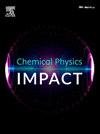响应面法对小球藻超临界提取工艺的参数研究及优化
IF 4.3
Q2 CHEMISTRY, PHYSICAL
引用次数: 0
摘要
普通小球藻具有脂质含量高、生长快、易于栽培和对环境适应性强等优点,是潜在的燃料生产原料之一。以普通小球藻为原料,进行超临界CO2萃取油的实验研究。在参数化研究中考察了温度、压力和萃取时间对油收率的影响。通过完整的sovov本文章由计算机程序翻译,如有差异,请以英文原文为准。

Parametric study and optimisation of supercritical extraction of Chlorella Vulgaris microalgae using Response surface methodology
Microalgae Chlorella vulgaris is one of the potential feedstocks for fuel generation due to its high lipid content, rapid growth, easier cultivation and adaptability to the environment. In this work, Chlorella vulgaris microalgae were selected as the feedstock for the extraction of oil using supercritical CO2. The effects of temperature, pressure, and extraction time on oil yield were investigated in parametric research. Extracted oil yield over time was further analyzed by the full Sovová mass transfer model, describing both the constant extraction rate (CER) and falling extraction rate (FER) periods effectively. Sovová model with high R2 and low residual error showed a close agreement between predicted and observed values of oil extraction yield. Process parameters were fine-tuned using Central Composite Design (CCD) and Response Surface Methodology (RSM). High R2 and R2adj values confirmed the effectiveness of a quadratic model in describing the effects of both single and interaction variables. Analysis of variance (ANOVA) study revealed that temperature, the interactive effect between temperature and time, and pressure and time have a significant effect on extraction yield due to their lower p-value. ANOVA validated the accuracy of the model due to its lower coefficient of variation. A close agreement in predicted yield of 42.85 wt% and an actual yield of 41.94 wt% was observed at optimized conditions of 32.6 °C, 25.4 MPa, and 130.2 min. Other fatty acids, including 23.73 % linoleic acid and 55.8 % oleic acid, were detected by HPLC analysis. The oil is found to be suitable for the production of biodiesel due to its high iodine and saponification values, along with low acid values. Chlorella vulgaris has the potential to be a feasible and scalable feedstock for renewable energy applications. Also, extraction involving SC![]() CO2 and its optimisation involving the RSM method showed an effective and statistically sound method for algal oil extraction.
CO2 and its optimisation involving the RSM method showed an effective and statistically sound method for algal oil extraction.
求助全文
通过发布文献求助,成功后即可免费获取论文全文。
去求助
来源期刊

Chemical Physics Impact
Materials Science-Materials Science (miscellaneous)
CiteScore
2.60
自引率
0.00%
发文量
65
审稿时长
46 days
 求助内容:
求助内容: 应助结果提醒方式:
应助结果提醒方式:


